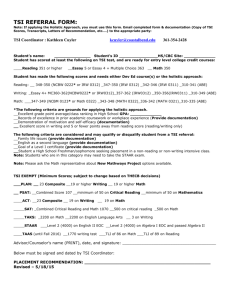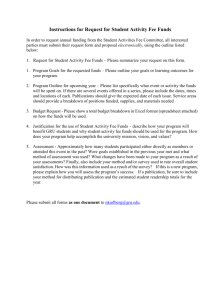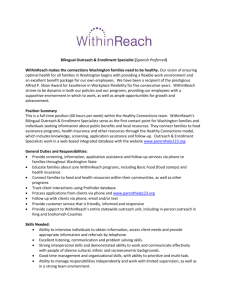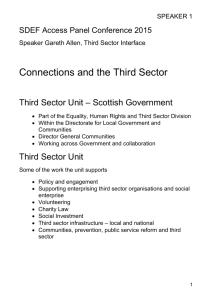variables proposed
advertisement
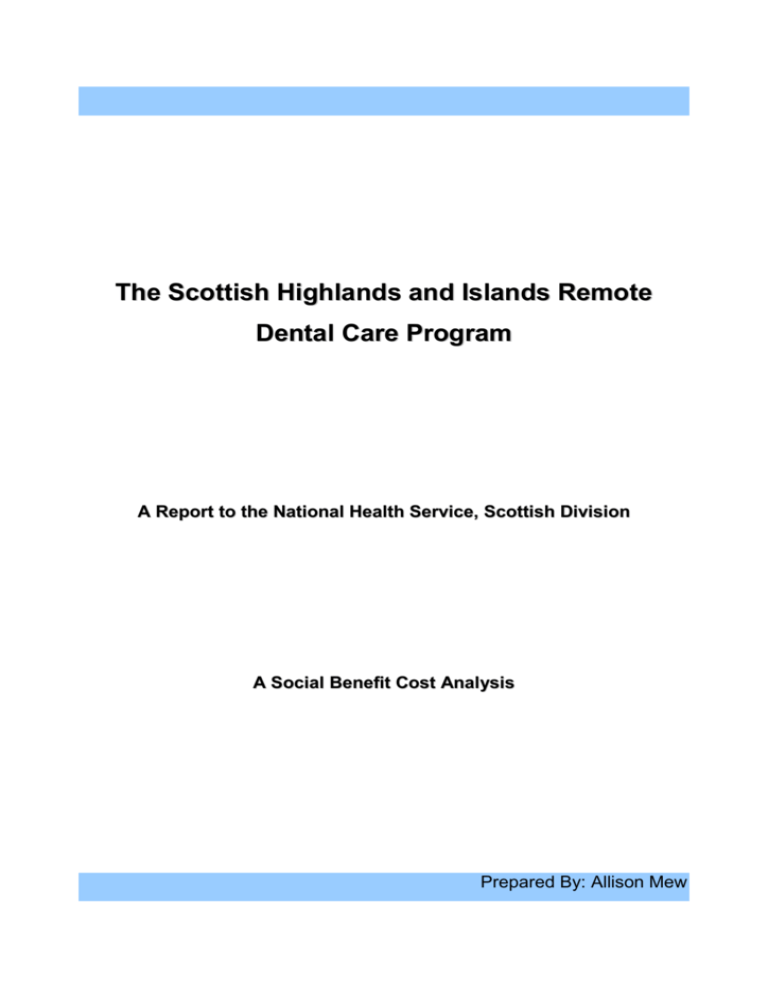
The Scottish Highlands and Islands Remote Dental Care Program A Report to the National Health Service, Scottish Division A Social Benefit Cost Analysis Prepared By: Allison Mew ECON3320 The Scottish Highlands and Islands Remote Dental Care Program Table of Contents Executive Summary……………………………………………………………………………. 3 1. Introduction…………………………………………………………………………………... 4 2. Methodology…………………………………………………………………………………. 4 2.1 Social Benefit Cost Analysis……………………………………………………….4 2.2 Decision Criteria……………………………………………………………………. 5 2.3 Key Variables………………………………………………………………………..6 2.4 Assumptions…………………………………………………………………………6 Capital and Operating Costs………………………………………………….. 6 Production Capacity…………………………………………………………….6 Financing………………………………………………………………………... 7 Salvage Values………………………………………………………………….7 Taxes, Duties, and Depreciation………………………………………………7 Travel Costs…………………………………………………………………….. 7 NHS Opportunity Costs………………………………………………………...8 Shadow Prices…………………………………………………………………..8 3. Analysis……………………………………………………………………………………… 9 3.1 Project Analysis…………………………………………………………………….. 9 3.2 Private Analysis…………………………………………………………................ 9 3.3 Referent Group Analysis…………………………………………………..............9 3.4 Sensitivity Analysis…………………………………………………………………10 Value of Patient Time………………………………………………………... ..11 Patient Fees…………………………………………………………………... ..11 3.5 Risk Analysis……………………………………………………………………… ..13 4. Conclusion…………………………………………………………………………………..13 Appendix………………………………………………………………………………………...14 References……………………………………………………………………………………. ..15 Allison Mew 2 ECON3320 The Scottish Highlands and Islands Remote Dental Care Program Executive Summary This report is designed to evaluate the efficiency of two proposals to improve the existing Dental system in remote areas of Scotland. The Teledentistry proposal has been suggested by a Canadian-based company Telemedicine Services Incorporated (TSI), in which videoconferencing equipment is used to provide a link between local doctors and specialists doctors in Aberdeen. They propose that doctors could perform the complex procedures locally while being guided by the specialists in Aberdeen. The Outreach proposal, developed by the Scottish Division of the National Health Service (NHS), suggests a venture in which specialists travel to 8 regional centers, so limit the distances patients would have to travel to get specialist treatment. Both projects are intended to begin in 2007 and continue through until 2021. The Social Benefit Cost Analysis performed considers the advantages of each project to the government, and the NHS, to the patients, and in the case of Teledentistry, to the financial institutions and to TSI. Results are analyzed at both market prices, and more importantly for the purpose of this report, efficiency prices to determine the project with the greatest net benefits. The sensitivity of the variables and the risks involved in either project are also considered. The analysis performed shows that the Teledentistry proposal has the greatest net benefits when it comes to the government and the patients. It is however, also the project that has the greatest amount of variability in relation to the sensitivity of the variables, and the project with the greatest amount of risk. The project is also likely to be rejected by TSI in the base case form as their internal rate of return is below their estimated cost of capital. The Outreach proposal, although showing lower net benefits than Teledentistry, still provides an improvement when compared to the existing system, and may be preferred if the level of sensitivity and risk is considered an issue with the Teledentistry proposal. The analysis was performed using variables derived from the best information available. It is recommended that if any of the variables change significantly that they are also altered in the analysis. This is especially the case for the fee that NHS would pay TSI per patient under the Teledentistry proposal, the value of which has yet to be agreed upon by both parties. Allison Mew 3 ECON3320 The Scottish Highlands and Islands Remote Dental Care Program 1. Introduction This report presents an analysis for the National Health Service (NHS) Scottish Division of two proposals intended to reduce the number of hospital visits required to treat specialist dental cases. There are currently 40 GDP’s servicing a population of approximately 250,000 people in the Scottish highlands and Islands, and any complex dental procedures have to be performed some distance away in Aberdeen (see Appendix 8 for a map of Scotland). The Teledentistry Project, as proposed by a Canadian company – Telemedicine Services Incorporated (TSI), would use video-conferencing equipment to provide a link between specialists and local doctors so that the procedures could be performed in the local GDP with the assistance of a specialist. The Outreach Project, as proposed by the NHS, suggests a system where specialists travel to select GDP’s located in regional centers. Each project is designed to reduce traveling time and costs of dental treatment to patients in remote areas. The report presents a social benefit cost analysis to determine the costs and benefits of both projects to the government; including the NHS, to TSI and to the patients. 2. Methodology 2.1 Social Benefit Cost Analysis Social Benefit Cost Analysis is designed to consider all benefits or costs of a proposed project to a group of interest in society. Traditional Benefit Cost Analysis tends to only consider those benefits that had official market values, where as the Social Benefit Cost approach considers those benefits or costs that have market prices as well as those that are not defined by the market. In doing so the analysis comprises of four sections; the Project, Private, Efficiency and Referent Group. For the purpose of this report the Private and Referent Group analysis are the most important as they show the actual gains to the private firm and to the government and people of Scotland. Project Analysis ~ Cost Benefit Analysis valued at market prices. Allison Mew 4 ECON3320 The Scottish Highlands and Islands Remote Dental Care Program Private Analysis ~ Costs and Benefits to the private firm (in this case TSI), and is derived from the project BCA minus cash flows such as taxation and financing to get the after tax profit for the firm. Efficiency Analysis ~ Costs and benefits valued at efficiency (opportunity cost) prices, to determine if there is an efficient use of resources. The analysis may include variables that where not included in the project analysis if they did not have a market value. Referent Group Analysis ~ Cost and benefits from the point of view of the various nominated stakeholders (in this case the Government and people of Scotland). The referent group analysis shows a breakdown off all the benefits or costs resulting from a projects implementation. For the purpose of this analysis the referent group shows the benefits of implementing a specific project (Teledentistry or Outreach) as opposed to remaining with the old system. The figures are calculated by subtracting the net benefits of the existing project from the net benefits of the proposed project to get the improvement from implementing a project. 2.2 Decision Criteria Analysis is carried out by projecting the cash flow over the life of the projects (15 years from 2007 to 2021) and then discounting the future values back to present values (2006) to derive their net present values (NPV). A positive NPV, i.e. an NPV ≥ 0, implies that the project is acceptable, while a negative NPV implies that the project runs at a loss and should not be undertaken. The higher the NPV the greater are the benefits and this can be used to indicate whether one proposal is more beneficial than another. However, the net present values from all components of the analysis need to be considered before any recommendations can be made. Internal Rates of Return (IRR) are also calculated for each analysis. The IRR shows the rate of discount at which the NPV is equal to zero. If the IRR is above the estimated cost of capital for the project then it is considered acceptable. However, the IRR gives no indication of how profitable the particular project will be. Cash flow is discounted at rates of 6%, 9% and 12%. Changing the rate of discount allows for a sensitivity analysis of all NPV’s, as there is an inverse relationship between the rate of discount and the NPV (as the discount rate increases the NPV decreases). Allison Mew 5 ECON3320 2.3 The Scottish Highlands and Islands Remote Dental Care Program Key Variables Appendix 1 shows the key variables used in this analysis. The variables reflect the input, cost and revenue data as well as the existing market conditions (such as rates of interest, depreciation and import duties) that are assumed to hold through out the duration of the project. The variables have been developed using the best information available at the time, and are subject to change. Because the project runs for 15 years it is impossible to accurately forecast what the variables will be in the future. This uncertainty can have significant impacts on the results of the analysis, and this should be considered when a final decision is being made. Information on the assumptions of these variables is discussed in detail in section 2.4, while an analysis on the degree of sensitivity of the most volatile variables is carried out in section 3.3. 2.4 Assumptions The analysis in this report has been made around certain assumptions about the key variables. Although a sensitivity analysis has been performed to assess the reliability of the assumptions it is recommended that if time permits the assumptions should be looked into in more detail to ensure the accuracy of the results obtained. Capital and Operating Costs In the analysis costs are divided between fixed (capital) and variable (operating). Fixed costs are constant and are incurred from 2006. Variable costs change depending on the number of patients and are incurred from 2007 onwards. Production Capacity NHS estimates that there will be 400 patients in need of treatment in the first year (2007) and that there will be an increase of 10 patients per year from 2008. Both the Teledentistry and Outreach projects expect to be able to treat 50% of eligible patients in 2007 and the full 100% from 2008 onwards. Allison Mew 6 ECON3320 The Scottish Highlands and Islands Remote Dental Care Program Financing The Teledentistry project is expected to be financed through a combination of grants and bank loans. TSI expects to obtain a ₤10000 grant from the Scottish Highlands and Islands Development Board in 2007, and intends to take out a loan of ₤80000 from Scottish Development Bank in 2006 at a 5% concessional rate of interest repayable over 10 years. TSI will also receive a payment from NHS of ₤140 per patient treated, although the fee rate has not been finalized. The Outreach project would be run by the NHS and would therefore be funded by the Government. Salvage Values Salvage values for the Teledentistry project is assumed to be 10% of the initial equipment cost minus the ISDN connection. The Outreach project also expects to have a 10% salvage value on the initial cost of equipment. Taxes, Duties and Depreciation It is assumed that Teledentistry equipment and software can be depreciated at 20% of initial cost per annum over 5 years for tax purposes. The company tax rate is assumed to be 30% of profits. A 20% import tariff is included in the market prices for Outreach specialist equipment, Teledentistry software and equipment, as well as the NHS equipment used in the Teledentistry upgrade. Travel Costs Under the existing system travel costs for patients are valued at the cost of travel tickets from the patient’s homes to the hospital in Aberdeen. The costs are taken for one person traveling alone and do not include costs of minors needing to be accompanied by parents, or elderly unable to travel alone. Travel costs of patients and specialists under the existing and proposed systems are also assumed to be constant, and do not allow for increases in the cost Allison Mew 7 ECON3320 The Scottish Highlands and Islands Remote Dental Care Program of travel. This may need further investigation considering the recent volatility in oil prices which could have the potential to increase the travel costs by a significant amount. Specialists time and travel costs are values at the specialists wage and the cost of return transport and accommodation respectively. Both time and travel costs are taken as constant and do not allow for increases in wage rates or the cost of transport, presenting the same problems as with patient travel costs. NHS Hospital Capital Cost Under either the Teledentistry or Outreach projects the number of patients requiring treatment in Aberdeen will decrease by at least 400. This frees up a consulting facility in 2008 that can be put to other use. The benefit of choosing one of the proposals versus the existing system is therefore assumed to be the value of the consulting facilities at 3500/square meter at 2006 prices with a life of 20 years. Uses the equivalent annual cost method to work out an annual cost to estimate any long-run cost saving. Shadow Prices Shadow pricing involves adjusting the observed market prices to reflect social benefit or social cost. In this analysis efficiency prices are calculated by taking the market prices and subtracting any import duties or taxes that have been added to them. For this project this applies to the 20% import tariff charged on any equipment and software used. The values of time and travel costs are also included in the efficiency analysis. Patient travel time is assumed to be valued at the market wage and taken as constant. However, no information was supplied as the type of market wage i.e. minimum wage, average wage. To accurately value patient time there would need to be some research into the demographic of patients so as to determine what wage is most likely to represent the group. If mostly older people where requiring specialist dental treatment then the market wage would likely be lower than if middle aged people where seeking treatment. Allison Mew 8 ECON3320 The Scottish Highlands and Islands Remote Dental Care Program 3. Analysis The full analysis of the Project, Private, Efficiency and Referent Group components can be seen in Appendices 2-5 respectively. It should be noted that the result discussed in sections 3.1 – 3.3 are subject to change, as is discussed in section 3.4 and 3.5. For this report the Efficiency Analysis will not be discussed in depth as it is only needed to obtain the Referent Group results. 3.1 Project Analysis The net benefits of each project are derived from subtracting the NPV of the proposal from the NPV of the existing system were it to continue. The resulting values show that both projects are preferred to the existing system at all discount levels. 3.2 Private Analysis TSI has positive NPV in the base case at discount levels of 6% and 9%, but a negative NPV at 12%. TSI’s IRR in the base case is 11.5% which is less than their estimated cost of capital at 12%, suggesting they may avoid the project. TSI Net Benefit 6% 9% 12% NPV = 62,367 24,004 -3,984 IRR = 11.5% Table: 3.2 Cases where TSI may choose to undertake the project are discussed more in the sensitivity analysis (Section 3.4). 3.3 Referent Group Analysis The referent group net benefits show that both projects offer a better alternative to the existing system (see Table 3.3). In the base case Teledentistry has higher net present values than Outreach; however TSI may not be willing to undertake the project as their IRR is less Allison Mew 9 ECON3320 The Scottish Highlands and Islands Remote Dental Care Program than their expected cost of capital. If this was the case then the Teledentistry project is no longer an option, and the Outreach project would have the most benefits. Teledentistry Government NHS Duties and Taxes Financial Institutions Patients Total RG Benefits 6% 9% 12% 356,969 271,684 207,517 289,306 228,229 182,306 80,843 66,141 55,601 -13,181 -22,685 -30,390 2,910,653 2,370,389 1,965,736 3,267,622 2,642,074 2,173,253 548,701 440,659 359,829 543,866 436,267 355,789 Outreach Government NHS Duties 4,836 4,392 4,040 Patients 2,684,976 2,186,601 1,813,323 3,233,677 2,627,261 2,173,152 Total RG Benefits Table: 3.3 As far as the distribution of referent group benefits goes, Outreach provides a greater benefit to NHS and the Government in general, while Teledentistry provides a greater benefit to patients. The Teledentistry proposal relies on financial institutions to provide significant funding, but the analysis shows that to finance the project the financial institutions would run at a significant loss. As a result the government may need to provide incentives for the institutions to provide the loan at the concessional rate of interest. Any incentives would then need to be factored into the analysis. 3.4 Sensitivity Analysis Because the variables used in the base case scenario are predicted rather than observed values, it is impossible to know with certainty what value the projects costs and benefits will take. To assure that the project will not be especially sensitive to changes in any of these predicted variables a sensitivity analysis is conducted. This involves looking at variables both internal and external to the project and allowing the variables to take a range of possible values, and then assessing the ensuing change in any of the net benefits. Variables analysed included the NPV at different discount rates, patient fees, value of patient time, patient growth per annum, NHS capital costs (cost/m2 of consulting facility), import duties, interest rate, tax rate, and the rate of depreciation. Of these, the only significant variables where found to be patient fees and the value of patient time. Allison Mew 10 ECON3320 The Scottish Highlands and Islands Remote Dental Care Program Value of Patient Time The Teledentistry project has higher benefits than the Outreach project when patient time is valued at the market wage. If the value of patient time increases beyond 2 times the assumed market wage the preferred project switches to Outreach. Because the market was valued as a constant then if the rate that the value increases is different to the rate of inflation the assumed wage would be incorrect. % of mkt wage Referent Group NPV (6%) Teledentistry Prefer Outreach 0% 32,785 367,151 T 50% 1,560,496 1,800,414 T 100% 3,088,208 3,233,677 T 150% 4,315,920 4,666,940 T 200% 6,143,631 6,100,203 O 250% 7,671,343 7,533,466 O 300% 9,199,054 8,966,728 O Table: 3.4.1 Patient Fees In the base case the fee that NHS pays to TSI is assumed to be ₤140 per patient, and it is noted that TSI hopes to negotiate a higher fee. At ₤140 TSI’s IRR is below 12% which would suggest it would not undertake the project unless the fee was raised. If the fee was increased to ₤150 per patient then TSI’s IRR increases to 13.9%, suggesting that it would undertake the project. At this fee rate the Teledentistry project still results in greater net benefits than can be achieved from Outreach. However, if the fee was increased further to ₤160 per patient, the benefits of Teledentistry are no longer greater than Outreach, and a switching of preferences would occur (See table: 3.4.2). Overall, the Teledentistry project has the greatest benefits with fee rates of ₤140 through to ₤151. At any fee rate greater than ₤151 Outreach will be preferred over Teledentistry, so it would therefore be impractical to set a fee rate above ₤151. Since TSI will not accept a fee rate of less than ₤142 as that is the first fee rate where their estimated cost of capital is equal to their IRR. Therefore, the fee rate should be set somewhere between ₤142 and ₤151, with the final fee rate dependent on the negotiating abilities of the individual parties. The only time that the Teledentistry project will be beneficial is at a fee rate of ₤150. Allison Mew 11 ECON3320 The Scottish Highlands and Islands Remote Dental Care Program Referent Group NPV (6%) Fee Prefer TSI IRR 3,233,677 T but O 11.5% 3,233,677 T but O 11.8% 3,261,642 3,233,677 T 12.0% £143 3,258,651 3,233,677 T 12.3% £144 3,255,661 3,233,677 T 12.5% £145 3,252,671 3,233,677 T 12.7% £146 3,249,681 3,233,677 T 13.0% £147 3,246,690 3,233,677 T 13.2% £148 3,243,700 3,233,677 T 13.5% £149 3,240,710 3,233,677 T 13.7% £150 3,237,720 3,233,677 T 13.9% £151 3,234,730 3,233,677 T 14.2% £152 3,231,739 3,233,677 O 14.4% £153 3,228,749 3,233,677 O 14.6% Teledentistry Outreach £140 3,267,622 £141 3,264,632 £142 Table: 3.4.2 It is also to be noted that provided everything in the base case scenario remains the same, and only the fee changes, that the preferences will remain the same and only depend on the results from the change of fees. However, if any other variables change (for example, the interest rate, rate of depreciation, or import tariff) then changing the fees could have different effects on preferences than those represented in Table: 3.4.3, 3.4.4 and 3.4.5. Tax Rate Fee Rate £140 £142 £151 20% T T T 25% T T T 30% T but O T T 35% T but O T T 40% T but O T but O T Table: 3.4.3 Depreciation Fee Rate £140 £142 £151 10% T but O T but O T 15% T but O T but O T 20% T but O T T 25% T T O 30% T T O Table: 3.4.4 Fee Rate Import Duties £140 £142 £151 10% T but O T O 15% T but O T O 20% T but O T T 25% T but O T T 30% T but O T T Table: 3.4.5 Allison Mew 12 ECON3320 The Scottish Highlands and Islands Remote Dental Care Program Tables show the changes in optimum outcomes at three different fee rates. A T referrers to the Teledentistry proposal being preferred, an O to the Outreach proposal being preferred, and T but O implies that Teledentistry is preferred but the IRR for TSI is below 12% so Outreach must be chosen as a next best alternative. The tables show that the outcomes are highly sensitive to any change in external factors, and are different depending on which fee rate is selected. Because the final fee rate is dependent on negotiations and the analysis is highly sensitive to the rate, it is recommended that another analysis be conducted after the fee rate has been set, to ensure accurate results for each of the proposals. 3.5 Risk Analysis With any proposal there is a level of risk involved that something unplanned may occur which yields unplanned and unwanted results. The Teledentistry project relies heavily on the use of videoconferencing equipment, which could be seen to have a high risk of malfunction or breakdown. There is also a risk from the point of view of the patient to allow an unqualified doctor perform the duties of a specialist. Patients may feel uncomfortable with this idea and would rather travel the further distance, and pay the respective transport costs, to get what they feel is a higher quality of care. The Outreach Proposal, although not providing as many benefits to the patients, is significantly less risky. 4. Conclusion From analysis of the base case scenario the Teledentistry proposal is shown to have the greatest Referent Group net benefits. However, the 11.5% IRR for TSI is below its estimated cost of capital of 12%, suggesting it may not undertake the project. If TSI chose not to accept the project then the next best option is to select the Outreach proposal, as even though the Teledentistry proposal is preferred, the Outreach proposal still offers significant benefits in comparison to the existing system. Assuming all variables remain the same the patient fee rate paid by the NHS to TSI should be somewhere in between ₤142 and ₤151 if Teledentistry is to be preferred. At fee rate over ₤151 the Outreach proposal will have greater benefits. Allison Mew 13 ECON3320 The Scottish Highlands and Islands Remote Dental Care Program Despite the Teledentistry proposal emerging as the option with the greater benefits, the sensitivity of the variables should be taken into consideration, and if any of the variables used in the base case change it is recommended that the BCA also be altered accordingly and analyzed to assure no significant change in outcome results. This is particularly important in the case of patient fees paid by the NHS to TSI. It would be recommended that this analysis only be taken as a guide until the fee rate is officially set, due to the sensitive nature of the results to changes in the fee rate. It is also recommended that the distributions of benefits be taken into account, as well as any risks involved in the proposal. The Teledentistry proposal offers greater benefits to Patients but the financial institutions run at a loss, implying there may be need for incentives. The Teledentistry proposal also comes with a higher risk than that of the Outreach proposal. The Outreach proposal shows most of the gains are attributed to the government, or more specifically to the NHS. If the gains to patients are deemed more important, then the Teledentistry proposal may be favored even if its overall net benefits are less than that of the Outreach proposal, and conversely if the risk involved is considered significant, Outreach may be the preferred option as it still runs at a benefit (even if not as great) but involves little risk. The report has not considered certain factors such as waiting times of patients under either scheme, or the attitudes of patients to the preferred form of treatment. If time and funding permit it is suggested that further investigation in these areas would be beneficial. Appendix Appendix 1: Variables Appendix 2: Project Analysis Appendix 3: Private Analysis Appendix 4: Efficiency Analysis Appendix 5: Referent Group Analysis Appendix 6: Sensitivity Analysis (non-significant variables) Appendix 7: Sensitivity of Patient Fees Appendix 8: Map of Scotland Appendices 1-8 are in MS Excel spreadsheet form. Allison Mew 14 ECON3320 The Scottish Highlands and Islands Remote Dental Care Program References AboutScotland (2005). Touring Map of Scotland. Available at: www.aboutscotland.com. Retrieved: 25 October, 2005. Campbell, H.F. and Brown R.P.C. (2003). Benefit-Cost Analysis: financial and economic appraisal using spreadsheets. Melbourne: Cambridge University Press. Allison Mew 15



